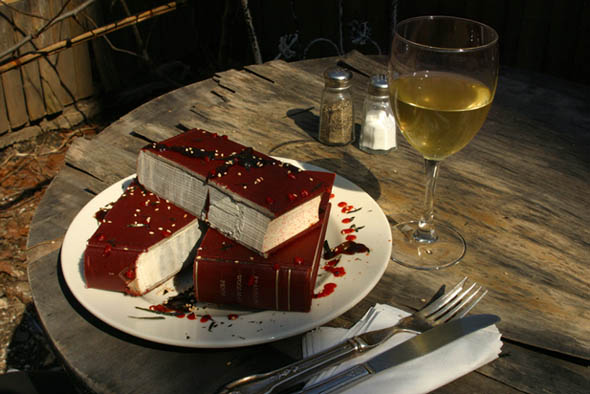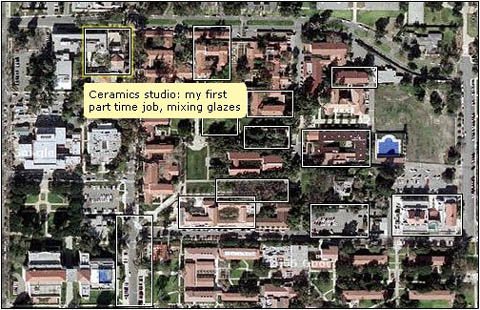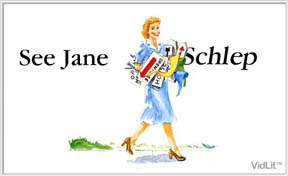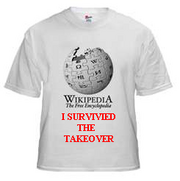Sony has secured a patent for a theoretical device that creates “sensory experiences” in the brain by sending ultrasonic pulses directly to the neural cortex – a non-invasive (that is, non-surgical) procedure, with the potential to give sight to the blind, or sound to the deaf. Gives a glimpse at what these tech giants are imagining for human entertainment further down the road.
From New Scientist – “Sony patent takes first step towards real-life Matrix”:
Elizabeth Boukis, spokeswoman for Sony Electronics, says the work is speculative. “There were not any experiments done,” she says. “This particular patent was a prophetic invention. It was based on an inspiration that this may someday be the direction that technology will take us.”
Link to patent.
(via Boing Boing)
Monthly Archives: April 2005
food for thought

(photograph by Gregory Vershbow)
mapping memory

Flickr has a wonderful annotation feature that allows you to attach notes to boxes drawn around sections of an image. Someone had the great idea of using Google satellite images of their hometown, or other significant locales in their life history, to make “memory maps.”
We’ve been thinking a lot about using film or music as a time-based “spine” for an electronic book. This experiment suggests the narrative possibilities of maps and images – not simply as reference points or illustrations on a page, but as dynamic agents. The folks at Grand Text Auto appear to be thinking along similar lines.
This also relates to the institute’s current Born Digital Competition, which deals with reinventing the page illustration in digital space. Memory mappers take notice!
weaving textbooks into the web
Mark Crane put forth an interesting possibility for digital textbooks in TechRhet Daily Digest Volume 2: Issue 74: “I’ve been thinking about ways to swap “playlists” of favorite online readings as a sort of virtual textbook, and it occured to me that social bookmarking sites such as del.icio.us and wurldbook might be a way to start to do this. For example, if you collected a series of links related to technical writing, you could publish that “playlist” to a service like del.icio.us and tag the readings as “tech comm” or “tech comm reader” or something for other people to use via a single url, perhaps.”
Mark’s idea is very exciting because it suggests a direction the future textbook might take as it learns to incorporate the vast and ever-expanding body of scholarship available on the web. An ephemeral “links” list could also be attached to a more durable body of content, like an ebook. The electronic textbook could offer these “playlists” as a dynamic index which would be continuously updated by the user community.
viral video lit
Faced with declining coverage of books in newspapers and magazines, writers are constantly looking for new ways to promote their work on the web. Literary blogs have done a lot to fill in the gaps left by print, covering lesser-known authors and titles translated from foreign languages, and even revisiting older works. And since many lit bloggers are writers themselves, the blogs serve as a virtual salon where writers and intellectuals come to spar about literature, recommend books, and share their own work. Cory Doctorow offers free, cc-licensed downloads of his novels, attracting readers, generating buzz, and bolstering sales of his books in print. Others are sneakier, deploying anonymous 5-star reviews under their own titles to boost sales on Amazon.
The latest, and probably most expensive, trick is video lit, or book shorts – brief little films (like movie trailers or music videos, but for books) designed to be spread virally through email, blog shout outs, and links, just like the digital tidbits – video clips, images, sites, articles – we stumble upon and circulate daily among friends and family. If people like what they see, they can buy the book (a convenient link to Amazon or Barnes & Noble is provided).
 It sounds a bit cock-eyed to advertise books as though they were movies, but proponents of the form say it can get results. There’s a piece in Wired that profiles some of the writers who have experimented with the form, and the little production houses that help them do it. The most frequently cited example is a Flash-animated encapsulation of “Yiddish With Dick and Jane,” a borscht-belt-infused pastiche of the iconic 1950s children’s reading primers. Not too long ago, the 2:45-minute film, produced by a company called Vidlit, was getting passed around incessantly on the web, while at the same time, the physical book flew like hot cakes off the shelves, going on to sell over 150,000 copies. Whether the two are related is hard to say. The book was pretty heavily promoted in stores as a no-brain-required gift item. But Vidlit touts this as a coup of viral advertising.
It sounds a bit cock-eyed to advertise books as though they were movies, but proponents of the form say it can get results. There’s a piece in Wired that profiles some of the writers who have experimented with the form, and the little production houses that help them do it. The most frequently cited example is a Flash-animated encapsulation of “Yiddish With Dick and Jane,” a borscht-belt-infused pastiche of the iconic 1950s children’s reading primers. Not too long ago, the 2:45-minute film, produced by a company called Vidlit, was getting passed around incessantly on the web, while at the same time, the physical book flew like hot cakes off the shelves, going on to sell over 150,000 copies. Whether the two are related is hard to say. The book was pretty heavily promoted in stores as a no-brain-required gift item. But Vidlit touts this as a coup of viral advertising.
BookShorts, a Canadian company, produces full live action films for its titles. I watched the book short for Susan Swan’s novel “What Casanova Told Me” and was not terribly impressed. It comes off like a preview for a TV movie adaption of a trashy book. But the Dick and Jane example, silly as it is, suggests how clever design and a quick one-two punch can get you a lot of mileage on the web. If people like the idea (and clearly they did), and if the film possesses a kind of must-see quality (the visual equivalent of a good one-liner, a zinger), then people might feel compelled to shuffle it voluntarily through the web. I could see this perhaps working for a political tract or manifesto, or for a religious text – something that is compulsive and seems to contain the seeds of larger truths or revelations. Imagine if this piece were connected to a book (click “Knife Party,” then again in new window, then watch “What Barry Says” by hitting “click here” at the bottom). Breathtaking visuals and a compelling political premise combine to whet the appetite for further reading.
genre-busting books
Bob Stein’s comment about Sekou Sundiata and his desire to have a DVD recording of Blessing the Boats in order to be able to savor it, “it wouldn’t do just to have a text transcription since hearing the many voices is a crucial aspect of the piece. it really was a genre-busting performed essay,” brings to mind the origin of poetry and its deep roots in the oral tradition. Rhymed stories that were to be sung, so people would still remember them generations later. This tradition is almost universally shared across cultures, and is still alive today. Think of hip-hop, epic poems, the Colombian vallenato, “Martn Fierro” that repository of everything Argentine, or the itinerant poets whom one can still hear in the markets of Central Asia and North Africa. It is precisely that centuries old internal rhythm which makes poetry practically untranslatable, but also gives us a tinge of shared pleasure when we hear poetry in a language we don’t understand.
The “genre-busting” aspect has been there all along. It was concealed when poetry became so obscure in the baroque, that one had to possess all the codes in order to understand it. It became a mind game and reading it was easier than listening to it. Then, in the 19th century, poetry began to look inside itself becoming aware of its raison d’tre; to give shape to an ontological reality, a sort of miracle that, in Baudelaire’s words, is flexible enough to adapt to the lyrical movements of the soul. So poetry was freed from form, inaugurating true genre-busting. The poem in prose was born. Musicians have set poems to music, or composed symphonic poems. Genre became blurry, because poetry was going back to what was meant to be.

All this brings us to the future of the book. I often think that today there is a sort of “presentism,” of looking towards the future in the form of the last gadget on which we can read, listen, watch, play, in a word, communicate. But there is a lot to learn from the past, from the visionaries that have been advancing history all along. Think of Alfonso X, the Wise, the poet king in whose court flourished Arab, Jewish and Christian cultures. Thanks to his books of poetry, mostly zejels (Arab-style poetry set to music) it has been possible to study Romanesque, Gothic and Arab instruments. Why? Through the illuminations (in the most complete sense of the word) that adorned his “Cntigas de Loor.” Those miniatures depicting Arab musicians playing the instruments upon which most of the modern orchestra originates. We now have in our hands the tools to advance this concept ad infinitum. And, what ‘s best, knowledge can be shared in a democratic way that resembles its origins.
 So, we wish to be able to hear poetry. Reading alone doesn’t do it any more. Sundiata belongs to an old, illustrious tradition, so do Bob Holman, Sarah Jones, Joan La Barbara, Pedro Pietri, Algarn, and the poets that in the 70’s dared to bring poetry to the forefront. Jaap Blonk’s poetry of sounds without words, “Messa di Voce,” that was so beautifully illuminated by Golan Levin, is another example of the hybrid. Poets have become performers, claiming their old role. Genre has been definitely busted. Think of hip-hop without its sounds, or Pedro, or Bob, or Sekou without theirs. I continue to be obsessed with a multiple book, the book of the future, the only one that does justice to poetry, and to them.
So, we wish to be able to hear poetry. Reading alone doesn’t do it any more. Sundiata belongs to an old, illustrious tradition, so do Bob Holman, Sarah Jones, Joan La Barbara, Pedro Pietri, Algarn, and the poets that in the 70’s dared to bring poetry to the forefront. Jaap Blonk’s poetry of sounds without words, “Messa di Voce,” that was so beautifully illuminated by Golan Levin, is another example of the hybrid. Poets have become performers, claiming their old role. Genre has been definitely busted. Think of hip-hop without its sounds, or Pedro, or Bob, or Sekou without theirs. I continue to be obsessed with a multiple book, the book of the future, the only one that does justice to poetry, and to them.
britannica storms wikipedia – networked accumulatio

![]() Beginning on as an april fool’s prank, Britannica’s hostile takeover of Wikipedia has snowballed over the past few days into a sprawling collaborative goof-off on a nerdy conspiracy theory. The article is currently being considered for deletion, or consignment to Wikipedia’s Bad Jokes and Other Deleted Nonsense archive. A funny specimen of web accumulatio (thanks, Infocult).
Beginning on as an april fool’s prank, Britannica’s hostile takeover of Wikipedia has snowballed over the past few days into a sprawling collaborative goof-off on a nerdy conspiracy theory. The article is currently being considered for deletion, or consignment to Wikipedia’s Bad Jokes and Other Deleted Nonsense archive. A funny specimen of web accumulatio (thanks, Infocult).
a new kind of newspaper
![]() Dan Gillmor points to what might be the beginning of something big, exciting and a little scary: user-generated newspapers. Bluffton Today, a free daily serving the small, but rapidly growing, South Carolina town of Bluffton (10,000 households, expected to double in the next five years), hits the racks this morning, filled with news, local events listings, and classifieds, culled in large part from reader contributions on the paper’s website. Bluffton Today.com is “a new kind of community website that joins with the Bluffton Today newspaper in a mission of helping Bluffton come together as a community.” Run in Drupal, a popular open source “community plumbing” platform, Bluffton Today weaves together blogs, photo-sharing, discussion forums, and classified ads into the living picture of a community. Everyday, the editors will assemble the print edition from content generated on the website, proving they mean what they say in the paper’s slogan, “It’s what people are talking about!” Browsing through, I found photo galleries ranging across topics like the recent passing of Pope John Paul, graduating Marines on Parris Island, the local SWAT team in training, a bar mitzvah, and life guards. Bluffton blogs (this is where you go when you click “news”) were discussing the Pope’s death, local sports events, surveys of the night’s television offerings, a golf story, and a plug for the Beaufort Humane Association.
Dan Gillmor points to what might be the beginning of something big, exciting and a little scary: user-generated newspapers. Bluffton Today, a free daily serving the small, but rapidly growing, South Carolina town of Bluffton (10,000 households, expected to double in the next five years), hits the racks this morning, filled with news, local events listings, and classifieds, culled in large part from reader contributions on the paper’s website. Bluffton Today.com is “a new kind of community website that joins with the Bluffton Today newspaper in a mission of helping Bluffton come together as a community.” Run in Drupal, a popular open source “community plumbing” platform, Bluffton Today weaves together blogs, photo-sharing, discussion forums, and classified ads into the living picture of a community. Everyday, the editors will assemble the print edition from content generated on the website, proving they mean what they say in the paper’s slogan, “It’s what people are talking about!” Browsing through, I found photo galleries ranging across topics like the recent passing of Pope John Paul, graduating Marines on Parris Island, the local SWAT team in training, a bar mitzvah, and life guards. Bluffton blogs (this is where you go when you click “news”) were discussing the Pope’s death, local sports events, surveys of the night’s television offerings, a golf story, and a plug for the Beaufort Humane Association.
Bluffton Today certainly seems like a powerful model for community reporting, but is there any potential here for serious journalism? So far, blogs have proven most effective as watchdogs for the mainstream media – calling out the bullshitters, filling in the gaps, refusing to let certain stories be buried or spun, and occasionally pulling off the dazzling revelation or exposé. They also paint an organic picture of how events ripple through society, registering, like a seismograph, the intensity, direction, and duration of a story. Recall the case of the tsunami, in which the million human voices crying out in the blogosphere balanced the monolithc coverage of the press. But this is not the same thing as providing consistent, exhaustive coverage of events. How could we get any reliable information without a professional class of journalists with the resources and training to extract truth from complex, hectic, or even dangerous circumstances? The blogs would largely dry up if they didn’t have the professional news to feed off of. This is not to say the news is complete, fair, or immune to corruption. But without it, web-based discussions would become incoherent.
There was a time when the only way to publicly comment or complain about a newspaper was in the paper’s own “letters to the editor” page. But we have entered an age in which readers have unprecedented opportunities to comment and even contribute to the news. Small communities like Bluffton might become entirely self-sufficient in the management of their information, while larger news outlets will probably have to evolve to incorporate grassroots journalism. Who knows? The New York Times might eventually establish a massive community portal on the Bluffton model to supplement its professionally generated news with contributions from community “stringers,” redefining what is meant by a story’s “source.”
But amidst all this change, the ingredient that must not be lost is editors. Bluffton Today reserves editorial authority, and this is precisely what makes them so interesting. They are betting that their content will be more colorful, nuanced, and (hold your breath) accurate, if they open up the news gathering process to the community. But they also seem to understand that this makes the role of editors all the more crucial. It’s an experiment worth watching.
Another recently launched initiative worth keeping an eye on (and participating in) is Our Media, a community-generated, community-maintained “home-brew” media warehouse, hosted by the Internet Archive. They are experimenting with guest editors for assembling the archive’s homepage, and with volunteer moderators for their various discussion forums. From the site:
“Ourmedia’s goal is to expose, advance and preserve digital creativity at the grassroots level. The site serves as a central gathering spot where professionals and amateurs come together to share works, offer tips and tutorials, and interact in a combination community space and virtual library that will preserve these works for future generations. We want to enable people anywhere in the world to tap into this rich repository of media and create image albums, movie and music jukeboxes and more.”
nothing has changed in 3,000 years

![]() Our exploration of digital technology and the revolution it has provoked in our reading and writing practice, tends to focus on the latest gadget and the newest software, but we are also concerned with the things that don’t change and the aspects of human communication that are so deeply a part of our nature that they can not be removed from our reading and writing systems. The first “Information Esthetics” lecture at the Chelsea Museum brought this to the fore last night. Robert Bringhurst spoke about hand-lettered manuscripts, and about typography that respects and preserves the texture and uniqueness of the hand-made mark. He argued for the humanity of fine craftsmanship. He even managed to convince me that slight variations in the shape of letterforms can serve as metaphors for our own individuality.
Our exploration of digital technology and the revolution it has provoked in our reading and writing practice, tends to focus on the latest gadget and the newest software, but we are also concerned with the things that don’t change and the aspects of human communication that are so deeply a part of our nature that they can not be removed from our reading and writing systems. The first “Information Esthetics” lecture at the Chelsea Museum brought this to the fore last night. Robert Bringhurst spoke about hand-lettered manuscripts, and about typography that respects and preserves the texture and uniqueness of the hand-made mark. He argued for the humanity of fine craftsmanship. He even managed to convince me that slight variations in the shape of letterforms can serve as metaphors for our own individuality.
He also made the point that the devices in our writing/reading systems are physiologically based. The average page is a size that can be held easily in our hands and read at arm’s length. Bringhurst showed a slide of an Egyptian manuscript. The size of the papyrus was very similar to page we use today, and the text was composed in blocks around images. Very much like magazine layouts. As I was admiring the beauty of the manuscript, Bringhurst said, “as you can see, nothing has changed in 3,000 years.” That shouldn’t shock me, but it did. I’ve been so absorbed in thinking about the next new thing, I’d forgotten that reading and writing is a very very old thing.
Interesting to think that whether we are reading something written on stone, papyrus, paper, or a computer screen, we need the same things we’ve aways needed: legibility, context, and “texture.” I’m radically summarizing Bringhurst’s lecture (hope I’m doing it justice). The way I understand it, texture is Bringhurst’s way of describing the particular kind of beauty we look for in cultural artifacts. Texture, is evidence of complexity, information, meaning and the imperfect human hand at work.
So, I’m thinking about how this “texture” manifests in digital manuscripts and it seems to me that it does so in several ways including: the craftsmanship of the digital document itself (which includes the code, the interface, and the composition), the richness of information/meaning that resides in virtual layers or as “links” within the text, and the way beauty can be crafted out of the physical material itself–light emitted by a computer screen.
(photo by Alex Itin)
